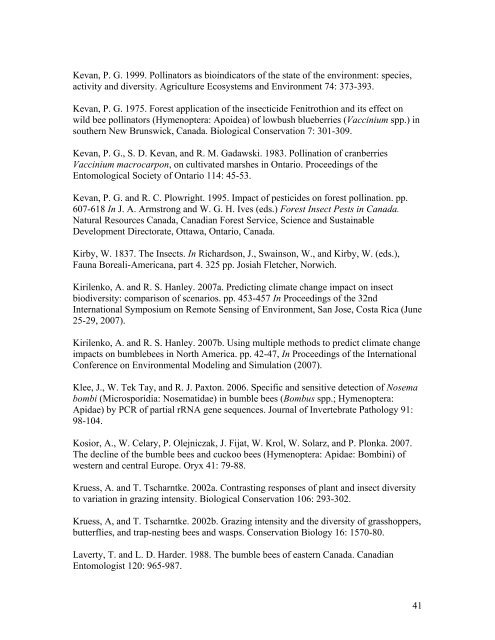Holm, S. N. 1966. The utilization and management <strong>of</strong> bumble bees for red clover andalfalfa seed production. Annual <strong>Review</strong> <strong>of</strong> Entomology 11: 155-182.Illinois Natural History Survey Reports. 2007. Diseases <strong>of</strong> Beneficial Insects. No. 392.p.8. Available online at http://www.inhs.uiuc.edu/inhsreports/2007/summer2007.pdf,accessed 3/21/2008.Ings, T. C., N. L. Ward, and L. Chittka. 2006. Can commercially imported bumble beesout-compete their native conspecifics? Journal <strong>of</strong> Applied Ecology 43: 940-948.Inouye, D. W. 1980. The effects <strong>of</strong> proboscis and corolla tube lengths on patterns andrates <strong>of</strong> flower visitation by bumblebees. Oecologia 45: 197-201.Irwin, R. E. and A. L. Brody. 1999. Nectar-robbing bumble bees reduce the fitness <strong>of</strong>Ipomopsis aggregata (Polemoniaceae). Ecology 80: 1703-1712.Irwin, R. E. and J. E. Malo<strong>of</strong>. 2002. Variation in nectar robbing over time, space, andspecies. Oecologia 133: 525–533.Javorek, S. K., K. E. MacKenzie, and S. P. Vander Kloet. 2002. Comparative pollinationeffectiveness among bees on lowbush blueberry. Annals <strong>of</strong> the Entomological Society <strong>of</strong>America 95: 345-351.Jennersten, O., D. H. Morse, and P. O'Neil. 1991. Movements <strong>of</strong> male and workerbumblebees on and between flowers. Oikos 62: 319-324.Jilian, L., W. Jie, P. Wenjun, A. Jiandong, G. Zhanbao, and T. Yuemin. 2005. Nosemabombi, a microsporidian pathogen <strong>of</strong> the bumble bee Bombus lucorum. Journal <strong>of</strong>Apicultural Science 49: 53-57.Johansen, C. A. 1977. Pesticides and pollinators. Annual <strong>Review</strong> <strong>of</strong> Entomology 22: 177-192.Johansen, C. A. and D. F. Mayer. 1990. Pollinator Protection: a <strong>Bee</strong> and PesticideHandbook. Wicwas Press, Cheshire, Connecticut.Judd, W. W. 1966. Studies <strong>of</strong> the Byron Bog in southwestern Ontario. XXIII. Insectsassociated with flowering leatherleaf, Chamaedaphne calyculata (L.) Moench.Transactions <strong>of</strong> the American Microscopical Society 85: 302-305.Kearns, C. A. and D. W. Inouye. 1997. Pollinators, flowering plants, and conservationbiology. BioScience 47: 297-307.Kearns C. A., D. W. Inouye, and N. Waser. 1998. Endangered mutualisms: theconservation <strong>of</strong> plant–pollinator interactions. Annual <strong>Review</strong> <strong>of</strong> Ecology and Systematics29: 83-112.40
Kevan, P. G. 1999. Pollinators as bioindicators <strong>of</strong> the state <strong>of</strong> the environment: species,activity and diversity. Agriculture Ecosystems and Environment 74: 373-393.Kevan, P. G. 1975. Forest application <strong>of</strong> the insecticide Fenitrothion and its effect onwild bee pollinators (Hymenoptera: Apoidea) <strong>of</strong> lowbush blueberries (Vaccinium spp.) insouthern New Brunswick, Canada. Biological Conservation 7: 301-309.Kevan, P. G., S. D. Kevan, and R. M. Gadawski. 1983. Pollination <strong>of</strong> cranberriesVaccinium macrocarpon, on cultivated marshes in Ontario. Proceedings <strong>of</strong> theEntomological Society <strong>of</strong> Ontario 114: 45-53.Kevan, P. G. and R. C. Plowright. 1995. Impact <strong>of</strong> pesticides on forest pollination. pp.607-618 In J. A. Armstrong and W. G. H. Ives (eds.) Forest Insect Pests in Canada.Natural Resources Canada, Canadian Forest Service, Science and SustainableDevelopment Directorate, Ottawa, Ontario, Canada.Kirby, W. 1837. The Insects. In Richardson, J., Swainson, W., and Kirby, W. (eds.),Fauna Boreali-Americana, part 4. 325 pp. Josiah Fletcher, Norwich.Kirilenko, A. and R. S. Hanley. 2007a. Predicting climate change impact on insectbiodiversity: comparison <strong>of</strong> scenarios. pp. 453-457 In Proceedings <strong>of</strong> the 32ndInternational Symposium on Remote Sensing <strong>of</strong> Environment, San Jose, Costa Rica (June25-29, 2007).Kirilenko, A. and R. S. Hanley. 2007b. Using multiple methods to predict climate changeimpacts on bumblebees in North America. pp. 42-47, In Proceedings <strong>of</strong> the InternationalConference on Environmental Modeling and Simulation (2007).Klee, J., W. Tek Tay, and R. J. Paxton. 2006. Specific and sensitive detection <strong>of</strong> Nosemabombi (Microsporidia: Nosematidae) in bumble bees (Bombus spp.; Hymenoptera:Apidae) by PCR <strong>of</strong> partial rRNA gene sequences. Journal <strong>of</strong> Invertebrate Pathology 91:98-104.Kosior, A., W. Celary, P. Olejniczak, J. Fijat, W. Krol, W. Solarz, and P. Plonka. 2007.The decline <strong>of</strong> the bumble bees and cuckoo bees (Hymenoptera: Apidae: Bombini) <strong>of</strong>western and central Europe. Oryx 41: 79-88.Kruess, A. and T. Tscharntke. 2002a. Contrasting responses <strong>of</strong> plant and insect diversityto variation in grazing intensity. Biological Conservation 106: 293-302.Kruess, A, and T. Tscharntke. 2002b. Grazing intensity and the diversity <strong>of</strong> grasshoppers,butterflies, and trap-nesting bees and wasps. Conservation Biology 16: 1570-80.Laverty, T. and L. D. Harder. 1988. The bumble bees <strong>of</strong> eastern Canada. CanadianEntomologist 120: 965-987.41
- Page 1 and 2: Status Review of Three Formerly Com
- Page 4 and 5: use as commercial pollinators. Dr.
- Page 6 and 7: B. Habitat requirementsB. affinis,
- Page 8 and 9: and with black hairs extending rear
- Page 10 and 11: Although this species was formerly
- Page 12 and 13: September 2007).RegionSouthernOntar
- Page 14 and 15: B. Pollination EcologyBombus terric
- Page 16 and 17: as recently as 2007, Massachusetts
- Page 18 and 19: Variety 1: As nominate form above,
- Page 20 and 21: the Rocky Mountains. Below are find
- Page 22 and 23: Historical records from within San
- Page 24 and 25: VI. CURRENT AND POTENTIAL THREATS -
- Page 26 and 27: impatiens to be transported into th
- Page 28 and 29: equest is made to APHIS, APHIS will
- Page 30 and 31: Insecticides are used in wild lands
- Page 32 and 33: eetles use commercial honey bee col
- Page 34 and 35: diseases by the commercial bumble b
- Page 36 and 37: Brown, M. J. F., R. Schmid-Hempel,
- Page 38 and 39: Fitzpatrick, U., T. E. Murray, R. J
- Page 42 and 43: Leonard, M. D. 1928. A list of the
- Page 44 and 45: Medler, J. T. and D. W. Carney. 196
- Page 46 and 47: Plowright, R. C., B. A. Pendrel, an
- Page 48 and 49: 48: 543-548.Stephen, W. P. 1957. Bu
- Page 50 and 51: Williams, P. H., M. B. Arau ́jo, a
- Page 52 and 53: Abbreviations for museums are as fo
- Page 54 and 55: Tennessee: Sugarlands, 12-Apr-1949,
- Page 56 and 57: H.C. Manis, Strange, U of ID; 2: Bu
- Page 58 and 59: Montrose, 5-Aug-1960, F., P., & M.
- Page 60 and 61: Lick Cr. 28 mi SE Union 4280 ft, 3-
- Page 62 and 63: N.E. Woodley, Strange, WSU; Richlan
















